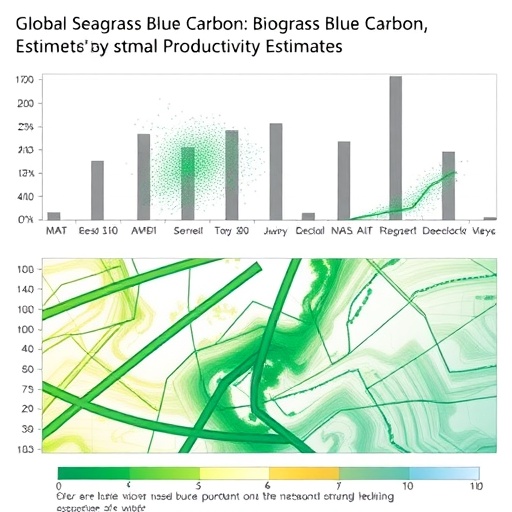In a groundbreaking contribution to marine ecology and climate science, a new study published in Nature Communications by Gomis, Strydom, Foster, and colleagues unveils comprehensive global estimates of seagrass blue carbon stocks, meticulously quantifying both biomass and net primary production on an unprecedented scale. This pioneering research not only sheds light on the vital role seagrasses play as carbon sinks but also significantly enhances our understanding of their contribution to global carbon cycling in the face of accelerating climate change.
Seagrasses, submerged flowering plants found in coastal regions worldwide, have long been recognized for their ecological importance in supporting marine biodiversity and stabilizing sediments. However, their capacity to sequester “blue carbon”—carbon stored in coastal and marine ecosystems—has remained poorly quantified until now. The study addresses this gap by integrating extensive field measurements, remote sensing data, and advanced modeling techniques to deliver the first harmonized global dataset that captures both the living biomass of seagrasses and their net primary production (NPP), the rate at which they convert atmospheric CO2 into organic carbon.
The significance of this research lies in its detailed assessment of seagrass ecosystems’ carbon stocks, which are critical for mitigating atmospheric CO2 levels. Prior estimates have often been fragmented and constrained to regional scales, leading to wide variability and uncertainty. By synthesizing data from diverse biogeographical zones—including tropical, temperate, and polar regions—the authors present a holistic picture that elucidates how seagrasses function as potent carbon reservoirs with dynamic productivity patterns shaped by environmental conditions.
Methodologically, the study employs an innovative fusion of satellite-derived data and in situ biomass sampling, calibrated through rigorous ground-truthing efforts. This approach allows researchers to overcome the spatial and temporal limitations typical of marine ecosystem assessments. The resulting global map of seagrass carbon stocks reveals notable hotspots where seagrass meadows concentrate large carbon stores, particularly in coastal areas with minimal anthropogenic disturbance, underscoring their ecological resilience and conservation value.
One of the pivotal findings of the study is the quantification of the net primary production rates of seagrasses, a metric that had been elusive on a global scale. The researchers demonstrate that seagrass meadows actively photosynthesize and fix substantial amounts of carbon annually, trajectories that are intimately linked to seasonal variability, water temperature, nutrient availability, and hydrodynamic regimes. This refined understanding helps pinpoint regions where seagrass carbon sequestration could be maximized, informing targeted conservation and restoration initiatives.
The study also explores the implications of seagrass biomass and productivity patterns for carbon accounting frameworks under international climate agreements. Given that coastal blue carbon ecosystems are increasingly incorporated into national greenhouse gas inventories, the robust estimates provided by this research offer critical data inputs, potentially influencing policy decisions around carbon credits and ecosystem service valuations.
Moreover, the authors highlight the vulnerability of seagrass meadows to anthropogenic pressures, including coastal development, pollution, and rising sea temperatures linked to global warming. The degradation of these habitats results in the release of stored carbon back into the atmosphere, creating a feedback loop that exacerbates climate change. By quantifying existing carbon stocks, the study implicitly emphasizes the urgency of safeguarding these ecosystems as natural climate solutions.
This research also advances the scientific discourse on carbon cycling by elucidating the contribution of belowground biomass, an often overlooked component of seagrass ecosystems. Rhizomes and roots play a crucial role in long-term carbon storage within sediments, yet their biomass and turnover rates have been historically challenging to measure. The integration of belowground metrics into the global assessment marks a significant step forward in understanding carbon persistence and ecosystem stability.
The comprehensive dataset compiled opens avenues for future interdisciplinary studies focusing on ecosystem services, carbon flux dynamics, and response to environmental change. It enables marine ecologists, biogeochemists, and climate modelers to refine predictive models of blue carbon sequestration and to evaluate the role of seagrasses in global carbon budgets with higher confidence.
Importantly, the study underscores the potential for seagrass restoration efforts to contribute significantly to climate change mitigation strategies. Restoration not only rehabilitates biodiversity and supports coastal protection but also reinstates the carbon sink function of degraded meadows. By providing quantitative benchmarks for carbon stocks and productivity, the findings equip practitioners and policymakers with scientifically grounded metrics to evaluate and optimize restoration projects.
The global scope of this research also provides a framework for monitoring temporal changes in seagrass carbon stocks using emerging remote sensing technologies and long-term ecological datasets. This capability is vital for assessing the effectiveness of conservation actions and detecting early warning signals of ecosystem degradation or recovery.
In conclusion, the research by Gomis and colleagues constitutes a landmark advancement in blue carbon science, providing an integrated, global perspective on seagrass ecosystem carbon dynamics. Their rigorous quantification of carbon stocks and net primary production not only enriches our scientific understanding but also offers practical insights for climate action, ecosystem management, and sustainable development goals.
As coastal ecosystems face mounting pressures worldwide, this study serves as a clarion call to mobilize conservation resources and leverage seagrasses’ natural carbon sequestration potential. It heralds a new era in blue carbon research, where robust, global-scale data drives informed decisions and fosters effective policies for a resilient, climate-secure future.
Subject of Research: Global quantification of seagrass blue carbon stocks in biomass and net primary production
Article Title: Global estimates of seagrass blue carbon stocks in biomass and net primary production
Article References:
Gomis, E., Strydom, S., Foster, N.R. et al. Global estimates of seagrass blue carbon stocks in biomass and net primary production. Nat Commun 16, 9530 (2025). https://doi.org/10.1038/s41467-025-64667-6
Image Credits: AI Generated




